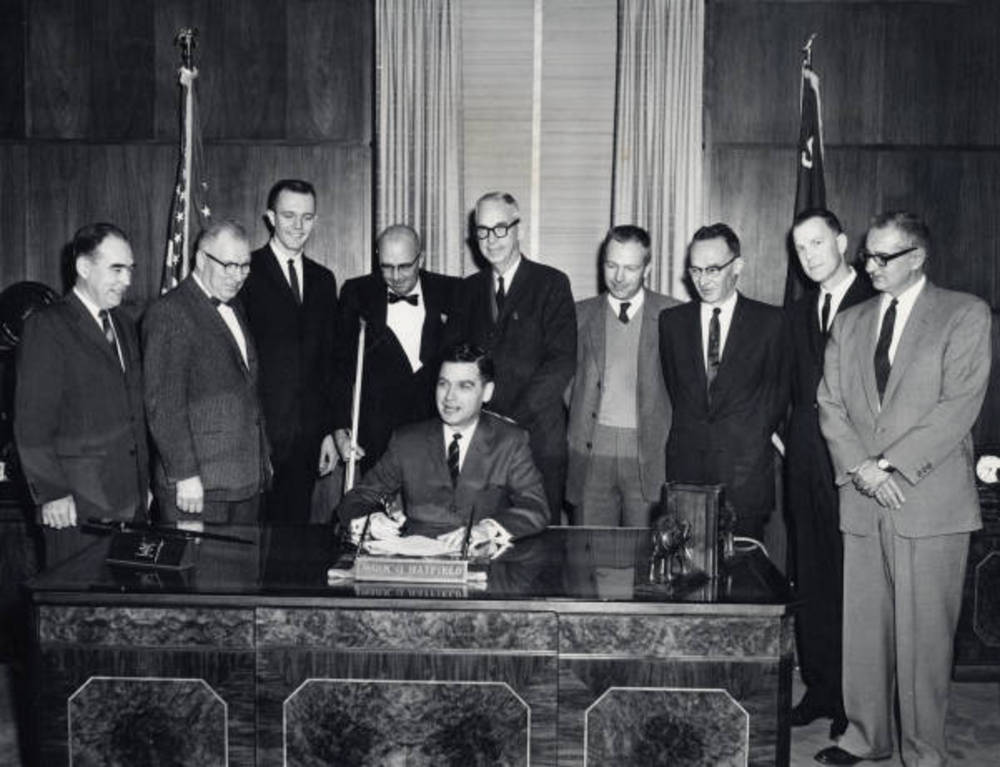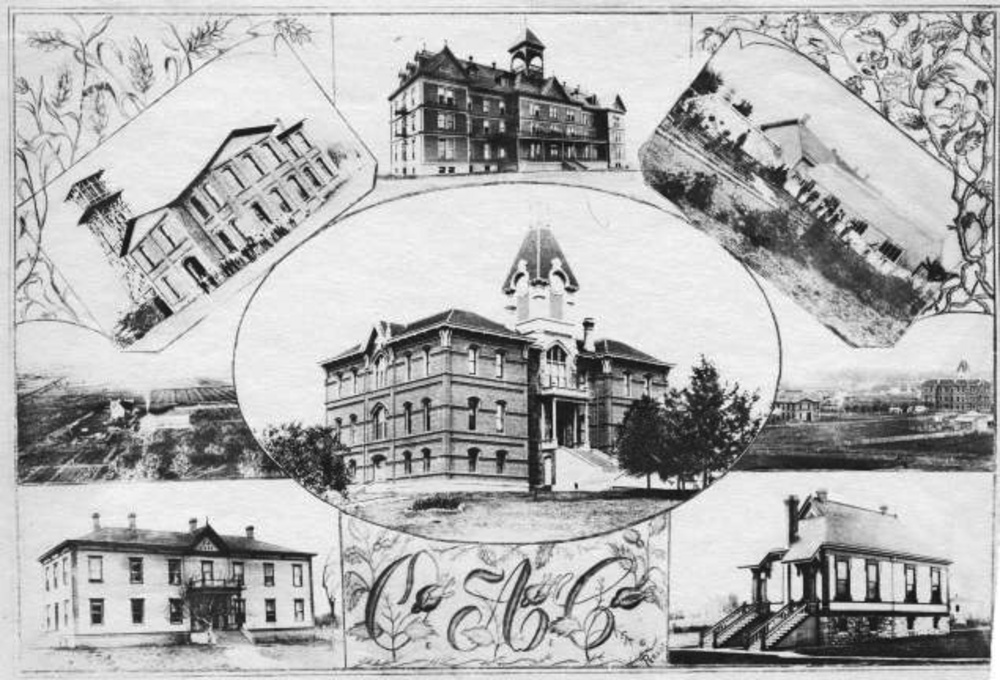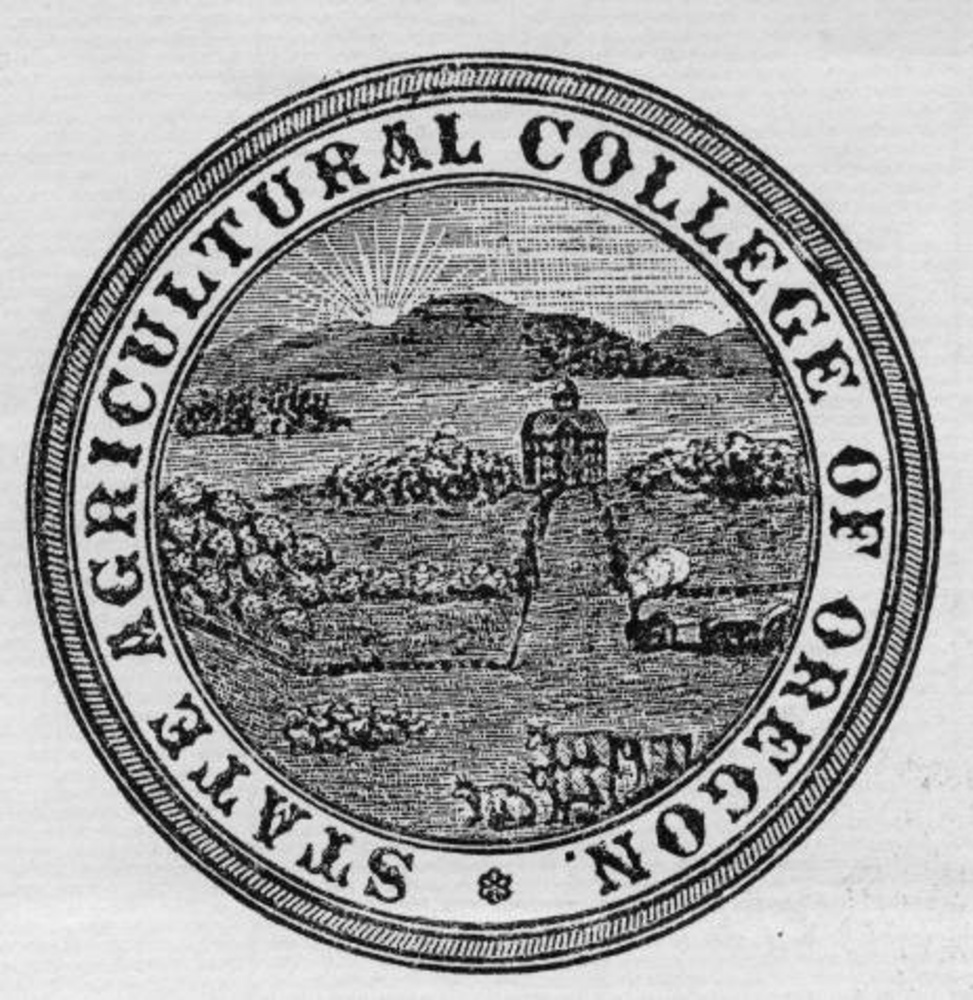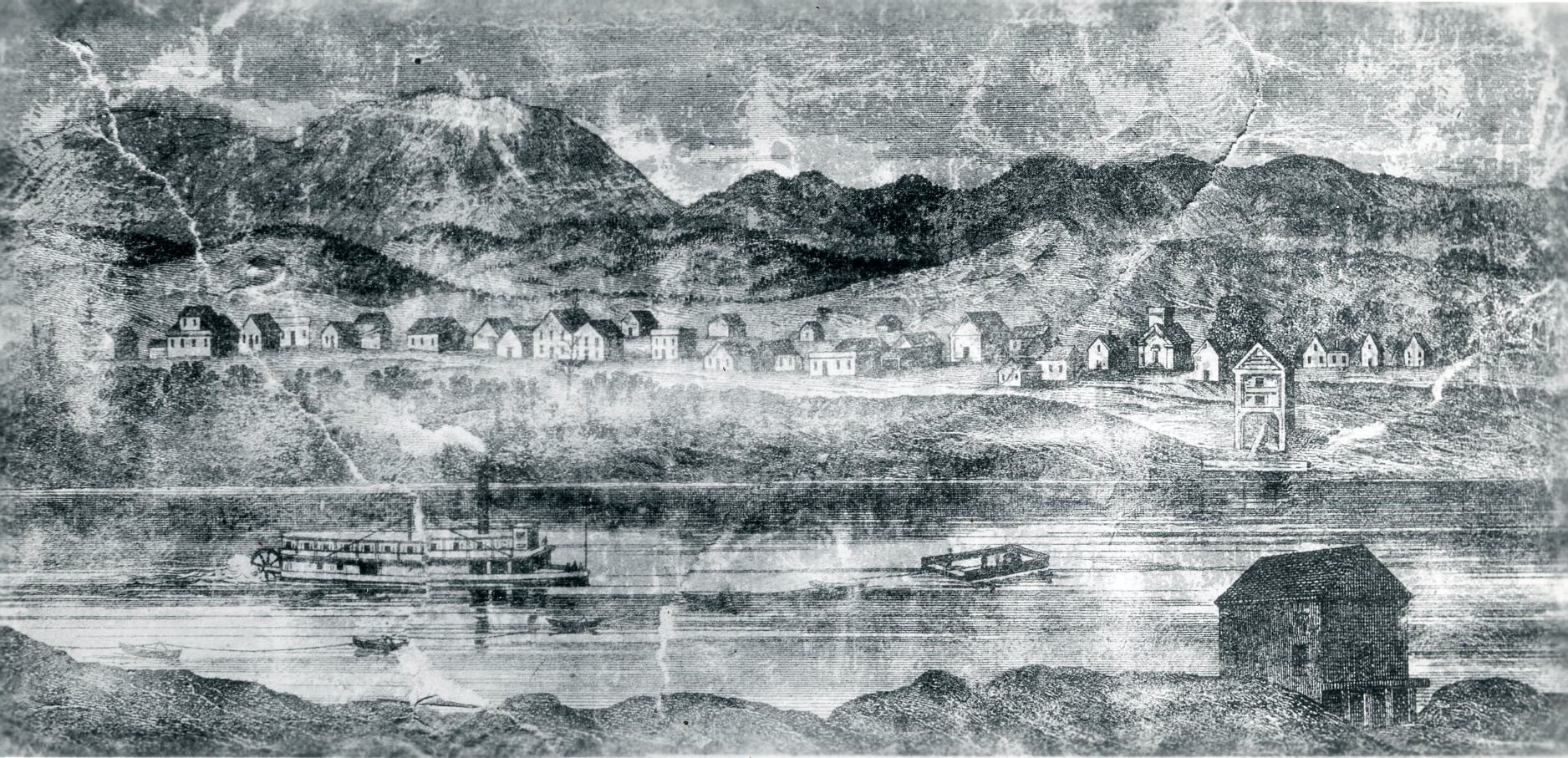Oregon State University (OSU) traces its roots to 1856, when Corvallis Academy was founded as the first community school in the Corvallis area. In 1858, the academy incorporated and became Corvallis College. Under the auspices of the Methodist Episcopal Church, South, Corvallis College began offering a four-year, collegiate liberal arts curriculum in 1865. On October 27, 1868, through the efforts of college faculty member and legislative clerk William Moreland and state senator C.B. Bellinger, the state legislature designated Corvallis College as Oregon’s land-grant institution under the provisions of the Morrill Act of 1862. The act granted Oregon 90,000 acres of land for creation of an endowment to support an agricultural college.
Despite the land-grant designation, Corvallis College, under presidents William A. Finley and Benjamin Arnold, struggled with funding and enrollment over the next twenty years. The land-grant lands, located in southern Oregon, sold slowly and created only a small endowment. In 1871, as required by the Morrill Act, the college purchased a thirty-five-acre farm west of downtown Corvallis, funded by more than one hundred local citizens. During this time, the college slowly developed curricula mandated by the Morrill Act—agriculture, engineering, and military science. The college, coeducational from the start, graduated its first class of three students in 1870.
From 1868 into the 1880s, the college was jointly administered by the Methodist Episcopal Church, South, and the state, with a board of trustees of mostly church-affiliated members. In 1885, the state assumed full control of the college, governed by a nine-member board appointed by the governor.
With the passage of the federal Hatch Act in 1887 and the second Morrill Act in 1890, additional funds became available to the college. The Hatch Act helped establish the Agricultural Experiment Station (1888), which provided the basis for much of the agricultural research done by OSU since then. In 1889, the college moved from downtown Corvallis to the newly built Administration Building, located on part of the college farm.
After Arnold’s death in 1892, presidents John Bloss (1892-1896), Henry Miller (1896-1897), and Thomas Gatch (1897-1907) directed the college. During this era, the college slowly developed the new campus, established a library, began intercollegiate athletic competitions, offered short courses to farmers, founded the college newspaper, and developed curricula in forestry and mining. Enrollment grew from 85 in 1890 to 1,351 in 1908, and international students attended for the first time.
William Jasper Kerr, president for twenty-five years beginning in 1907, helped transform the college from a small regional school to one of national importance. When Kerr took office, enrollment stood at approximately 1,300 students and the faculty consisted of 40 members; by 1930, enrollment exceeded 3,300 students and the faculty numbered more than 180. Kerr reorganized the academic structure of the college, establishing the schools of Agriculture, Commerce, Engineering and Mechanic Arts, and Domestic Science in 1908; the schools of Forestry and Mining in 1913; the School of Pharmacy in 1917; and the School of Vocational Education and Division of Service Departments in 1918.
The campus infrastructure grew considerably during Kerr’s tenure. In 1907, the 225-acre campus consisted of thirteen buildings valued at $229,000. In 1932, the 555-acre campus consisted of forty-two buildings valued at $7,500,000. Known informally as Oregon Agricultural College (OAC) in the 1890s and early 1900s, that name became official in 1907 and was changed to the Oregon State Agricultural College (OSAC) in 1927.
The federal Smith-Lever Act of 1914 provided for extension services in agriculture and home economics at land-grant institutions. Oregon’s Extension Service, established by OAC in 1911, predated the federal mandate. KOAC radio, the progenitor of Oregon Public Broadcasting, began broadcasting in January 1923 and was used by the Extension Service to disseminate information to farmers. OAC received accreditation from the National Council in Education in 1924 and the Association of American Universities in 1926.
In 1929, the state legislature created the Oregon State System of Higher Education to bring all of the state’s public higher education institutions (including OSAC) under one board and eliminate duplicative programs. In the 1930s, several programs at OSAC were eliminated; some were ultimately restored.
Despite reduced finances and enrollment during the Great Depression and the reorganization of Oregon’s public higher education, OSAC managed to maintain through the 1930s under the leadership of George Peavy, a longtime dean of forestry. The college’s 1933 “Iron Men” football team tied the powerful University of Southern California by a score of 0-0, while using only eleven players. OSAC conferred its first doctoral degrees in 1935, and it acquired the nucleus of the McDonald Forest, its research forest,in northern Benton County.
In 1937, the college’s name changed to Oregon State College (OSC). During World War II, OSC commissioned more cadets than any other non-military institution in the nation and trained 4,812 servicemen as part of the Army Specialized Training Program. Several faculty members served in the military or conducted war-related research.
Returning veterans created another enrollment boom in the post-war years—nearly 7,500 students by 1947—resulting in the hiring of additional faculty and the construction of new buildings. Post-war growth continued through the 1950s under August Strand (1942-1961). Oregon State strived to become a more complete institution of higher education and new academic and research programs were developed, including several with other countries. As a result of these new programs, in 1961 OSC traded the “College” in its name for “University.”
The 1960s, under President James H. Jensen, were characterized by considerable success in athletics—two football bowl appearances, national championship in cross country in 1961, and seven NCAA track and field individual champions—new degree programs in the humanities and social sciences, and designation in 1968 as a Sea Grant university. Enrollment doubled, jumping from 7,900 in 1960 to 15,800 in 1968, OSU’s centennial year. Under the leadership of Robert MacVicar (1970-1984) in the 1970s, OSU constructed several new academic, administrative, and student housing buildings; opened cultural centers for Native American, Hispanic, and African American students; and made the departments of oceanography and veterinary medicine into schools.
Fluctuating enrollment and budgets defined the 1980s and 1990s under presidents MacVicar, John Byrne (1984-1996), and Paul Risser (1997-2002). Despite this uncertainty, OSU added new research centers and facilities, established several endowed faculty chairs, developed distance education programs and a branch campus in Bend, and constructed new academic buildings and a greatly expanded library. Research grant funds increased by more than 50 percent in the 1990s, and OSU was designated a Space Grant university in 1991. Enrollment increased from 13,836 in 1996-1997 to 16,788 in 2000-2001.
During the first decade of the twenty-first century, OSU continued to experience variable state funding, but enrollment growth remained steady and private gifts increased substantially. Edward Ray became president in 2003 and created a strategic plan that established three primary focus areas based on the university’s teaching and research strengths. In 2004, OSU became a Sun Grant institution, one of two nationally to hold the land, sea, space, and sun grant designations. Athletics achieved national success with two baseball national championships in 2006 and 2007. Fall 2008 enrollment exceeded 20,000 students for the first time, and in 2023, enrollment was at 36,636 students.
-
![Oregon Agricultural College campus, 1912.]()
OSC campus, 1912.
Oregon Agricultural College campus, 1912. Oreg. State Univ. Archives, L1010114
-
![Recycling event at OSU's Memorial Union, April 2008.]()
OSU Memorial Union Quad, recycling at, 2008.
Recycling event at OSU's Memorial Union, April 2008. Courtesy Oreg. State Univ. News & Comm. Svs
-
![OSU School of Forestry's McDonald Research Forest, about 1981.]()
OSU, Coll. of Forestry, research forests, ca. 1981.
OSU School of Forestry's McDonald Research Forest, about 1981. Oreg. State Univ. Archives, College of Forestry Photo Collec., P61
-
![Govenor Mark O. Hatfield signs legislation changing the name of Oregon State College to Oregon State University, March 6, 1961.]()
Hatfield, Mark, OSU name change, 1961.
Govenor Mark O. Hatfield signs legislation changing the name of Oregon State College to Oregon State University, March 6, 1961. Oreg. State Univ. Archives, Harriet's Collec., HC2227
-
![Sports fields at OSC campus, 1947.]()
OSC campus, 1947.
Sports fields at OSC campus, 1947. Oreg. State Univ. Archives, Harriet's Collec., HC48
-
![Student map of OSC campus, 1934.]()
OSC student map, 1934.
Student map of OSC campus, 1934. Oreg. State Univ. Archives, Library Photo Collec., P83 acc 2004:052
-
![OAC lower campus, showing (l to r) Education Hall, Benton Hall and Apperson Hall, about 1905.]()
OAC, lower campus, ca. 1905.
OAC lower campus, showing (l to r) Education Hall, Benton Hall and Apperson Hall, about 1905. Oreg. State Univ. Archives, Harriet's Collec., HC40
-
![OAC Cadets with Carriage Factory in background, 1901.]()
OAC cadets, 1901.
OAC Cadets with Carriage Factory in background, 1901. Oreg. State Univ. Archives, Harriet's Collec., HC0596
-
![Oregon Agricultural College building montage, 1891.]()
OAC montage, 1891.
Oregon Agricultural College building montage, 1891. Oreg. State Univ. Archives, Harriet's Collec., P40
-
![Benton Hall, 1889.]()
OAC, Benton Hall, 1889.
Benton Hall, 1889. Oreg. State Univ. Archives, Harriet's Collec., HC0038
-
![OAC seal, 1889.]()
OAC seal, 1889.
OAC seal, 1889. Oreg. State Univ. Archives, Memorabilia Collec.
-
![OAC President William A. Finley, about 1870.]()
Finley, William A., ca. 1870.
OAC President William A. Finley, about 1870. Oreg. State Univ. Archives, Presidents of Oreg. State Univ. Photo Collec., P1:2
-
![OAC's first graduating class, 1870, included Robert M. Veatch, Alice E. Biddle, and James K. P. Currin.]()
OAC, first grad class, 1870.
OAC's first graduating class, 1870, included Robert M. Veatch, Alice E. Biddle, and James K. P. Currin. Oreg. State Univ. Archives, Harriet's Collec., HC883
-
![Corvallis College, about 1868.]()
Corvallis College, ca. 1868.
Corvallis College, about 1868. Oreg. State Univ. Archives, Harriet's Collec., HC1344
-
![Benton Hall, March 2009.]()
OSU, Benton Hall, 2009.
Benton Hall, March 2009. Photo by Theresa Hogue
Related Entries
-
![Corvallis]()
Corvallis
Nestled on the west side of the mid-Willamette River, Corvallis is domi…
-
![Corvallis and Eastern Railroad]()
Corvallis and Eastern Railroad
Built in the 1870s by T. Egerton Hogg in a fit of over-opportunistic bo…
-
![Corvallis streetcar system]()
Corvallis streetcar system
On December 17, 1889, a group of real estate developers, led by Zephen …
-
![Warren Morton Washington (1936–2024)]()
Warren Morton Washington (1936–2024)
A groundbreaking climate scientist, Warren M. Washington played a major…
Related Historical Records
Map This on the Oregon History WayFinder
The Oregon History Wayfinder is an interactive map that identifies significant places, people, and events in Oregon history.
Further Reading
Groshong, James W. The Making of a University, 1868-1968. Corvallis: Oregon State University, 1968.
Landis, Lawrence A. “Oregon State University: A Key Component of Benton County’s History.” In A Pictorial History of Benton County. Corvallis: Corvallis Gazette-Times and Benton County Historical Society and Museum, 2000.
Landis, Lawrence A. A School for the People: A Photographic History of Oregon State University. Corvallis: Oregon State University Press, 2015.
Oregon State University Archives. Chronological History of Oregon State University.
Oregon State University. Office of Budgets and Institutional Research. 2001 Fact Book. Corvallis: Oregon State University, 2001.
Robbins, William G. The People's School: A History of Oregon State University. Corvallis: Oregon State University Press, 2017.



















